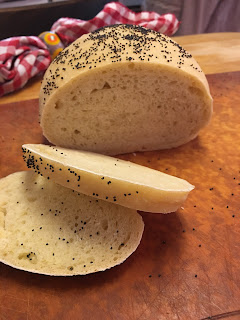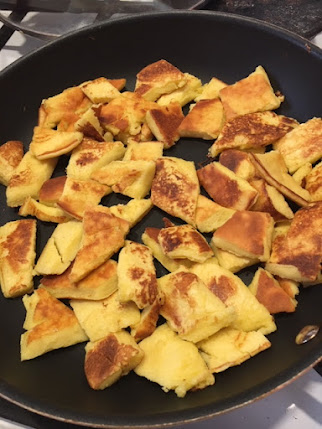What happens when a dedicated potica baker decides to make her first-ever New Orleans Mardi Gras king cake for her husband's birthday? And then he suggests that she take advantage of the leftover walnut potica filling in the freezer.
Here's what happened last year at our house: We seem to have created the world's first Mardi Gras Potica! One of my friends from Slovenian language class even gave it a new name: Pustica! (To learn more about Pust, the Slovenian version of Mardi Gras, you can read my Mardi Gras, Slovenian Style post, from the early days of this blog.)
For many years in my family, we have celebrated a cluster of February birthdays with Mardi Gras king cakes from Louisiana. Last year, because of pandemic shipping challenges, I decided it was time to try a homemade version. I never intended to do something transgressive, although it did occur to me that poticas and king cakes both use what is technically a brioche dough. Once I decided to use the same walnut-sugar cinnamon filling we use in my family's version of potica, I imagined that this homemade king cake might taste a bit like Slovenia's most famous dish.
But I never imagined how closely that slice of king cake would resemble potica. A rather strange and gaudy potica, with those bands of gold, green, and purple sugar. And with thicker layers of dough than I would normally make. And who ever heard of a potica with confectioners' sugar icing?
 |
| with marzipan filling |
 |
| with walnut filling |
But it was good, no doubt about it. So good that I repeated it again this year. This time, at my husband's urging, I tried a marzipan filling. Although it tasted wonderful, it was too thick to spread easily, so for now I would recommend the tried-and-true walnut version.
One other twist to this unplanned hybrid: For the dough, I wanted to use the artisan bread approach I discovered just before lockdown and have been using ever since. I was happy to discover that a blogger named Cynthia had already adapted a challah recipe from the newest edition of "Artisan Bread in Five Minutes a Day" to prepare a very authentic-looking king cake.
For details, see the recipe below. Or use your own favorite potica recipe and see what happens if you add all those special New Orleans touches. And don't forgot to add that little figure of a baby. Whoever finds it is supposed to bring the king cake to the next party!
New Orleans King Cake + Potica Filling: Pustica!
The artisan-style dough I used is adapted from a king cake recipe in Cynthia's blog
What a Girl Eats. She describes it as an adaptation of one of the brioche varieties (actually a challah recipe) in the new edition of
Artisan Bread in Five Minutes a Day. The walnut-honey filling is from my
family's potica recipe.
Dough
1 cup milk, lukewarm
1 package yeast
1-1/2 teaspoons salt
2 large eggs, beaten
1/4 cup honey
1/4 cup butter, melted
3-1/2 cups all purpose flour
Filling
2 cups finely ground walnuts
1/3 cup sugar
1 teaspoons cinnamon
pinch of salt
2 tablespoons melted butter
2-3 tablespoons honey
Icing
confectioners' sugar
warm water
vanilla
Decorations
purple, green and gold sugar
King Cake baby (or substitute an almond)
For the dough: Combine all ingredients except flour in a large bowl or lidded container and mix until well blended. Gradually add flour, mixing by hand until dough forms a soft ball. (Note that dough is not kneaded in this "artisan" approach.) Cover loosely and let rise for 2 hours or until dough doubles in size and then flattens out. Dough can be used right away but will be better if refrigerated for a few hours (or as long as 5 days) before rolling out and filling.
To roll out: Roll the chilled dough into a 1/4 inch thick rectangle. If you use all the dough, you will have a 12 x 18 inch rectangle--and a very large king cake. The first time I made this, I set aside about a quarter of the dough and rolled the rest into a 9 x 12 inch rectangle. (The remaining dough can be used to make small brioche rolls.)
To fill and shape: Follow the method described in my family potica recipe: Combine the walnuts, sugar, and cinnamon. Brush the rectangle of dough with melted butter. Sprinkle the walnut mixture on the dough and drizzle with a little honey. Roll up the dough from one of the long sides of the rectangle. Shape the long roll into a circle and join the ends together. Place the round (seam side down) on a greased or parchment-lined baking sheet. Cover and let rise for 45 minutes. Bake at 375 degrees for 35 minutes. Let cool.
To decorate: When cake is completely cool. spread/drizzle it with a thin confectioners sugar icing and decorate with alternating bands of green, gold and purple sugar. (You can purchase sanding sugar in Mardi Gras colors or make your own with food coloring.)
For the final traditional touch: After baking, slip a small plastic or ceramic figure of a baby into the cake. Whoever finds the baby is supposed to supply the king cake for the next Mardi Gras party!





























